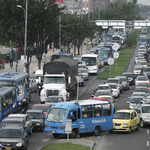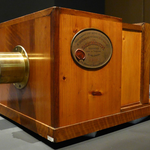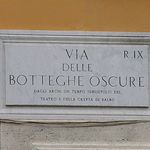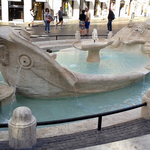Basilica di San Giovanni in Laterano
The name "Laterano" probably derives from Plauzi Laterani that was the name of the ancient Roman family from which Constantine confiscated the land as it took part in the plot against Nero 300 years before. According to the legend however "Laterano" goes back to Nero whose inauspicious persanality lightens unspent in the memory of the descendents.
The extravagant emperor being in the constant search of new impressions dreamt of an incredible one either for the most fanciful flatterers: he wanted to give birth to a child. He orders the doctors to survey
his pregnancy and terryfied of being killed they made him swallow a tadpol. When a tadpole became a frog they made it come out with a powerful laxative.
Nero put thenew-born frog on a carriage of silver and gold and brought her out escorted by a wet-nurse. But one day after walking near a spring of water, the frog jumped down and disappeared between the lawns. So
Latitan rana means running away frog from which the latin term "Laterano" is derived and therefore the name of the Basilica of San Giovanni "In Laterano"
The first thing done by the Pope after he had been crowned in Vatican was to come to the Piazza di Porta San Giovanni in Laterano and enter the basilica with a solemn procession for to take it into "possession". The Pontiff is called a "bishop of Rome" and San Giovanni is a cathedral of Rome as a city and therefore as a whole world.
It was founded by Pope Melchiades (311-314) on the land belonging to the Plauzi Laterani family.The land was gifted by the Constantine Emperor to the Pontiff together with the big barracks of the Equites Singulares.
On the remains of it the primitive Basilica with only 5 naves was put up. It was dedicated to Salvatore and later to the saints Giovanni Battista and Evangelista.
Until 1305 it was official residence of the Popes who after the return from the Avignon exile moved to Vaticano.
Devastated by vandals it was restored by the pope San Leone Magno in the fifth century and by Adriano I (VIIIth century).
Damaged by the earthquake in 896 it was rebuilt by Sergio III in 1905 and magnificently decorated by Nicolo IV in 1288-92.
Destroyed again in 1308 from the fire it was immediately rebuilt by Clement V but still it was fired once more in 1361. However it was reconstructed again during the pontificates of Urban V and Gregorio XI
by Giovanni di Stefano from Siena.
In the end of 1500 Sixtus V gave an order to Domenico Fontana to add the "lodge of the blessings" in the square by restoring the ancient citadel of the decayed christianity turned into a pile of ruins
In 1646 Innocent X expecting the next Holy Year decided to make in order the Basilica and entrusted the work to Borromini asking him to respect the old structures.
The ceiling of the Cinquecento, the Tabernacle of the Trecento, the Cosmatesque floor with the altar from which only the Pope is permitted to celebrate Mass are remained until now.
In 1735 Clement XII ordered Alessandro Galilei to make the new façade with 12 statues of Christ and Apostles and the porch that la Porta Santa leads to.
In silver simulacres inside the Gothic Canopy there are the heads of the Saint Peter and Paul
Above the altar of the Sacrament one can see a fragment of the table on which Jesus had the last dinner.The blood of Christ is also kept there brought to Rome by the centurion Longino.
In the Basilica and in the Lateran Palace the Councils of 1123,1139, 1179, 1215, 1512 had place.
Until the XVIIIth century the buildings remained isolated in a rural environment that encouraged developing the traditional San Giovanni holiday in the night of June 24 (the birthday of Saint John the Baptist). The folks united in a merry party and went to eat up hundreds of snails to the taverns and to the huts specially constructed on the lawn near the palaces of Laterano or between its remains. During the holiday they watered the lawn with wines from Castles.
Apart from the Basilica Lateran palaces encloses the palace itself and the Baptistery that looks into adjacent Piazza San Giovanni in Laterano.
The Lateran Palace finished with a big haste and with the incredible rhythm of all the sistine buildings was created by Domenico Fontana in 1586-89 in the area of the Patriarchio which was the papal residence untill Avignon exile. The construction cost not so much thanks to the use of marbles and stone obtained from very accessible quarries consisted of ancient ruins and either thanks to the perfect management.It is one of the best works of Fontana and of the late Cinquecento (XVth century).
Later it was turned into hospital and in the XIXth century was occupied by museums. After the museums were moved into Vaticano the palace enjoyed the privilege of being extraterritorial and to ratify the Lateran pacts which were signed just in this building. Since 1967 it's been a seat of the roman vycarship (the main door was damaged by a bomb in 1993).
The baptistery was commissioned by Constantine on a place of the Ist century's villa and of IInd century's baths. Sisto III added the atrium and the popes Ilario and Giovanni IV added the chapels from the sides of the octagonal interior. In the centre there is a chain of two orders of architraved columns supporting the dome and enclosing the urn used for baptism by immersion.
Worth of attention are: mosaics of the Vth century in the Chapel of Saint Rufina of the Vth century, the mosaic decoration of the apse and the triumphal arch dating to theVIIth century in the Chapel of San Venanzio, the aisles of the main gate dating to the XIIth century in the Chapel of Saint John Evangelist.
In the centre of the Piazza di San Giovanni in Laterano the highest and the most ancient obelisk of Rome which is 47 meters high.
It was raised by the pharaohs Tutmosi II and IV (second part of theXVth cent. a.c.) in front of the Ammon temple in Tebe and was transported to Rome by Constantine II in 357. Set up in Circo Massimo and fallen down by the earthquake it was found again in 1587 and placed in the center of the square by Domenico Fontana.

 The records of Rome. Big numbers, not always enviable, for a big city.
The records of Rome. Big numbers, not always enviable, for a big city. New Phot-O-Matic section. To spend some time looking at photos (also) of Rome.
New Phot-O-Matic section. To spend some time looking at photos (also) of Rome. The administrative, urban, toponymic and imaginative subdivisions of Rome.
The administrative, urban, toponymic and imaginative subdivisions of Rome. Notice for tourists: in Rome you drink for free. Historical fountains and 'big noses'.
Notice for tourists: in Rome you drink for free. Historical fountains and 'big noses'. Free museums return on the first Sunday of the month.
Free museums return on the first Sunday of the month.